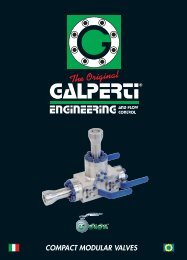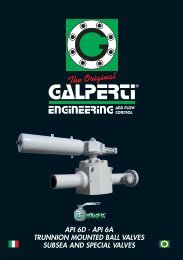Download productsheet 1 (.PDF, ~9MB) - PFF Group
Download productsheet 1 (.PDF, ~9MB) - PFF Group
Download productsheet 1 (.PDF, ~9MB) - PFF Group
Create successful ePaper yourself
Turn your PDF publications into a flip-book with our unique Google optimized e-Paper software.
G-LOK ®<br />
– The Advantages<br />
The G-LOK ® Connector is designed to offer the strength and sealing integrity of<br />
a welded joint and the versatility of a mechanical joint. It serves the same<br />
purpose as a bolted flange assembly, with the advantages of being more easily<br />
installed, lighter and smaller.<br />
A self-energized, pressure activated connection, the G-LOK ® clamp-type<br />
connector consists of four basic elements:<br />
• (1) Hub<br />
• (2) Clamps<br />
• (3) Seal<br />
• (4) Bolting<br />
G-LOK ® std free position<br />
The hubs are usually welded to pipe; the seal is installed and the bolting is<br />
tightened on the clamps to form a pipe connector that provides superior<br />
strength and leak integrity. The G-LOK ® is commonly used in service with<br />
temperatures of up to 650°C. The G-LOK ® also<br />
excels in high pressure applications, where<br />
working pressure of 30,000 psi is not<br />
uncommon.<br />
The G-LOK ® clamp has been designed for the<br />
optimum strength of a bolted connection.<br />
Since the bolts are perpendicular to the axis of<br />
the pipe, they do not receive direct bending<br />
and pressure loads. This system of clamping<br />
provides greater strength than ANSI or API<br />
G-LOK ® std made-up position flanges at a fraction of the seal size and<br />
weight as a result of this design. Less bolting<br />
torque is required for proper seating of the seal.<br />
The design of the connector provides considerable stored energy in the system G-LOK ® recessed free position<br />
when compared with ANSI or API flanges. This stored energy works to provide<br />
leak resistance during thermal cycling and<br />
maintains proper bolt loading.<br />
When properly installed, the G-LOK ® will<br />
usually provide greater bending and torsional<br />
strength than the connecting pipe. The full<br />
face contact of the connector resists bending<br />
and ensures rigidity not provided by other<br />
clamp-type connectors. The pressure and<br />
temperature limitations are determined only<br />
by the materials of construction.<br />
G-LOK ® recessed made-up position<br />
4<br />
G-LOK ® shrouded free position<br />
G-LOK ® shrouded made-up position<br />
HOW THE G-LOK ® CONNECTORS SEALS<br />
The seal ring in the G-LOK ® resembles a ”T” in cross section. The base of the ”T”<br />
is the rib that is held by abutting hub faces as the connection is made up. The<br />
top of the ”T” forms the lips that seal against the inner surfaces of the hubs.<br />
In the assembly of the connection, the clamps fit over the two hubs, and as they<br />
draw the hubs together the seal ring rib ensures proper seal alignment.<br />
As the hubs are drawn together by the clamp assembly, the seal ring lips deflect<br />
against the inner sealing surfaces of the hubs. This deflection elastically loads<br />
the lips of the seal ring against the inner sealing surface of the hub, forming the<br />
self-energized seal. Internal pressure reinforces this seal, so the sealing action of<br />
the G-LOK ® is both self-energized and pressure energized.<br />
G-LOK ® clamp connectors are interchangeable with other connectors designed<br />
and manufactured according to the same standard.






